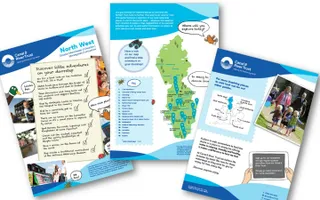Free guides for fun days out
Download our free guides - over 100 places to visit
The charity making life better by water
Making life better by water
Meandering through the Welsh countryside the Monmouthshire & Brecon Canal is one of our most beautiful and peaceful waterways following the line of the Usk Valley through the Brecon Beacons National Park.
Show me places within...
Explore your nearest canals and ways to enjoy them Find walks, activities and more within:
The Monmouthshire & Brecon Canal, or Mon & Brec for short, is a true hidden gem. A haven for wildlife and a favourite with nature-lovers, walkers and cyclists. The northern section forms part of the Taff Trail Long Distance Footpath, a 55 mile route that can be walked or cycled, starting at Brecon Basin and ending in Cardiff.
The navigable section of the canal runs for approx. 36 miles from Brecon to Five Locks, Cwmbran.
A favourite with holiday boaters, there are loads of activities to enjoy on this beautiful canal. Relax on a boat trip, take in the local heritage, there are lime kilns and old workings from our industrial heritage that can be seen all along its length, spot wildlife, buzzards, red kites, herons and dragonflies.
Enjoy a family day out to the wonderful sites of Brecon Basin, Llangynidr locks or Goytre Wharf, with its historic limekilns or pop in for a snack at Pontymoile or any of the numerous canal side pubs or cafes.
Down to the sea is a new partnership between the Trust and the Brecon Beacons National Park Authority. A series of walking routes have been created suitable for families and will allow children to positively engage with the industrial past. To help, Down to the sea (Welsh version) features a number of exciting short animated videos that reveal the historic story of the Monmouthshire and Brecon Canal.
This peaceful and almost entirely rural waterway is a must-see for nature-lovers. The Llangattock escarpment is designated as a Special Site Of Scientific Interest (SSSI), and is the entrance to an extensive cave network.
The canal passes through a World Heritage Site, which contains industrial landmarks such as the Big Pit Mining Museum. The Cefn Flight of fourteen locks has also been recognised as being of international significance, and is on Cadw's list of Scheduled Ancient Monuments.[18]
As the Mon & Brec is not currently accessible from any other waterway, most boaters cruise it on a hire-boat. There are several fleets based on the canal.
The Mon & Brec actually started life as two separate canals: the Brecknock & Abergavenny Canal, and the Monmouthshire Canal. The 35-mile navigable section seen today is mostly the former. In the 1790s, the Monmouthshire Canal Company received its Act of Parliament at the same time that the Brecknock & Abergavenny was being planned. Following discussions, it was decided to link the two at Pontymoile. The Monmouthshire Canal, including a branch from Malpas to Crumlin, was opened in 1799 with the Brecknock & Abergavenny extending from Brecon to Gilwern by 1800, finally reaching Pontymoile by 1812.
Both canals were supported by horsedrawn tramroads that were mainly used to bring coal, limestone and iron ore from the hillsides. The canal played a significant part in our industrial heritage, connecting Hill's tramroads to the iron works in Blaenavon and the forges at Garnddyrys.
Though originally constructed to transport coal, lime and agricultural products the canal was used extensively by ironmasters and industrialists as their main transport network, bringing the raw iron ore up the canal from Newport to Llanfoist Wharf and thence by tramroads to the iron works and returning with trams loaded with iron, the finished product. Remains of this heritage can still be viewed along the canal today these include wharfs and lime kilns.
The Blaenavon area and a section of the canal were granted World Heritage status in 2000 in recognition of its historical significance.
In 1880 the Monmouthshire & Brecon Canals were taken over by the Great Western Railway. Within 35 years, commercial carrying had all but ceased.
Throughout the 20th century various parts of the Monmouthshire Canal and its Crumlin Arm were filled in for road construction. The line was all but obliterated through Cwmbran, and was effectively unnavigable further north. It's fair to say that this beautiful part of our canal network came close to disappearing altogether. But vigorous campaigning by canal enthusiasts heralded a new dawn for the canal, and in 1968 restoration work from Brecon to Pontymoile began in earnest.
Recent developments have included a complete regeneration of the terminus at Brecon, and various works continue to reclaim the navigation between Pontymoile and Newport.
Part of the Crumlin Arm has also been restored, and the Fourteen Locks Canal Centre is open regularly to the public.

Sign up to our newsletter and discover how we protect canals and help nature thrive


